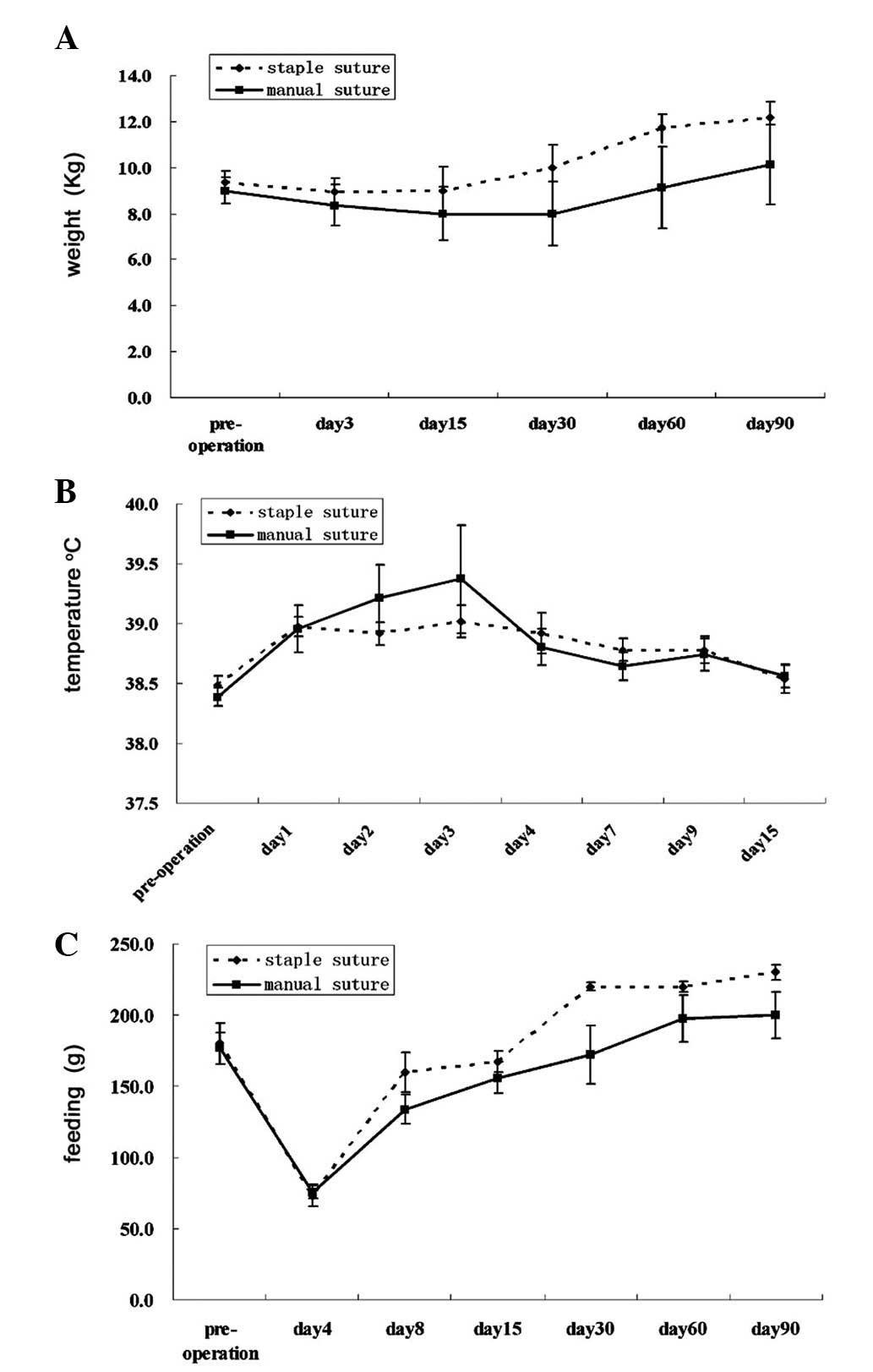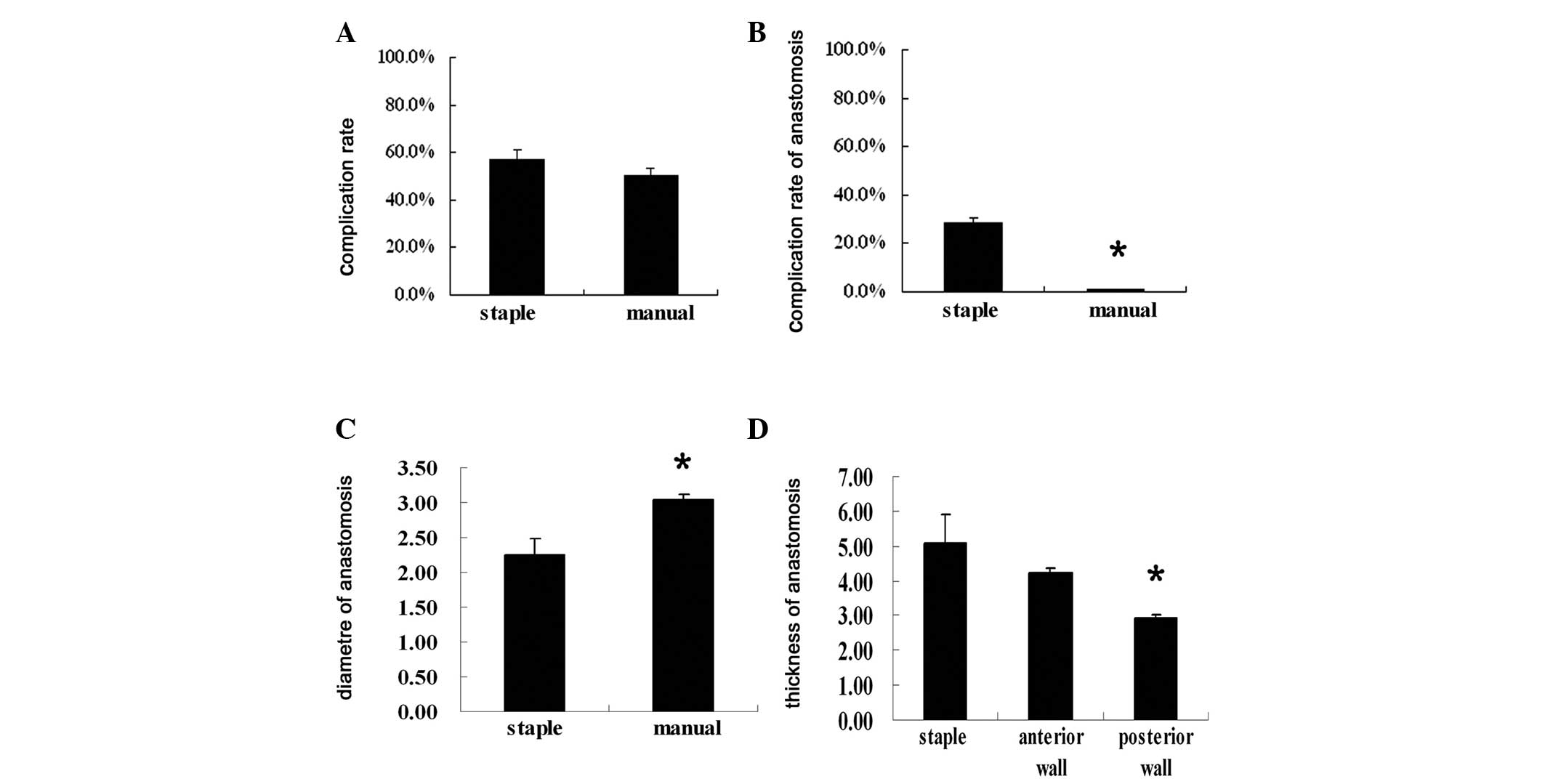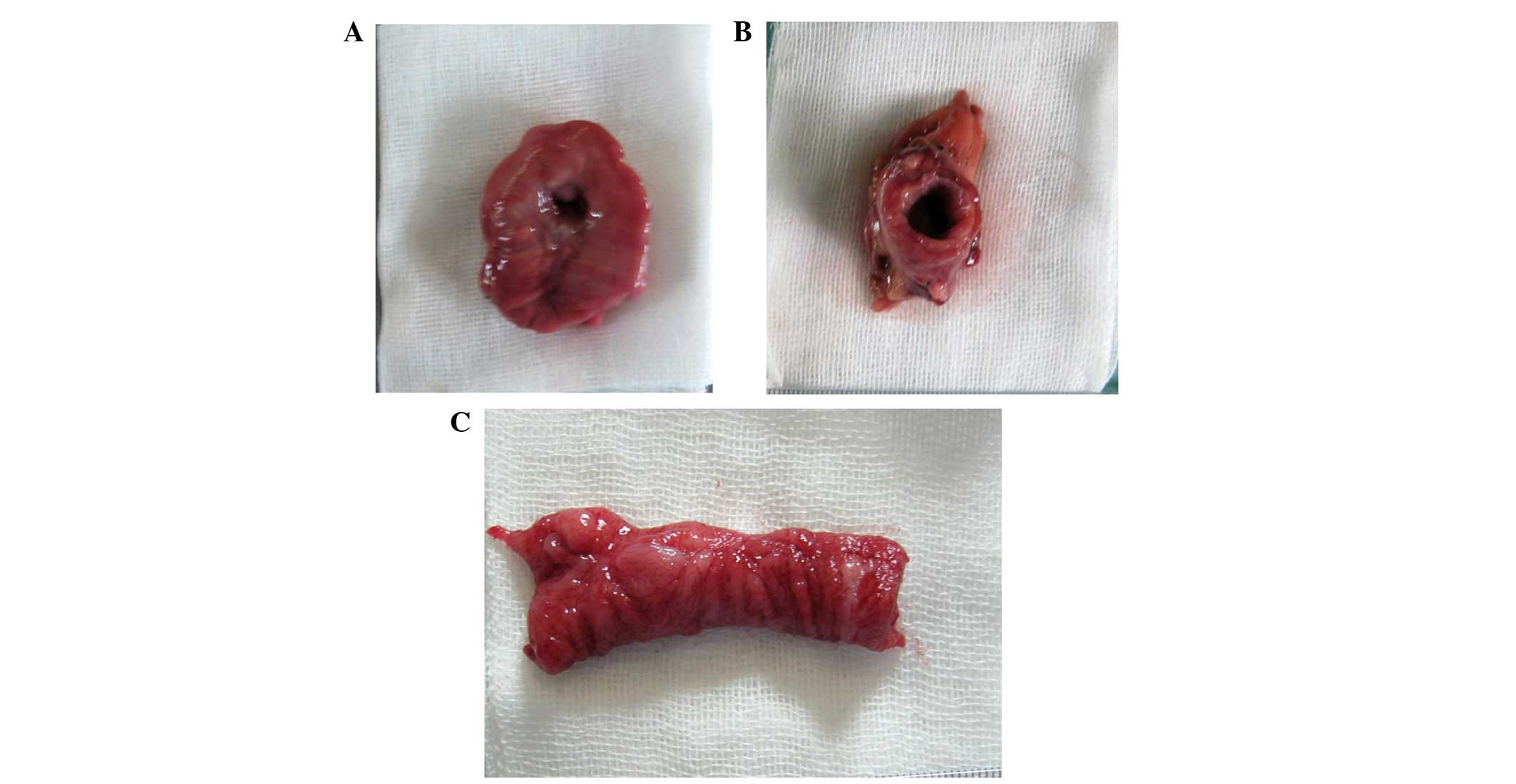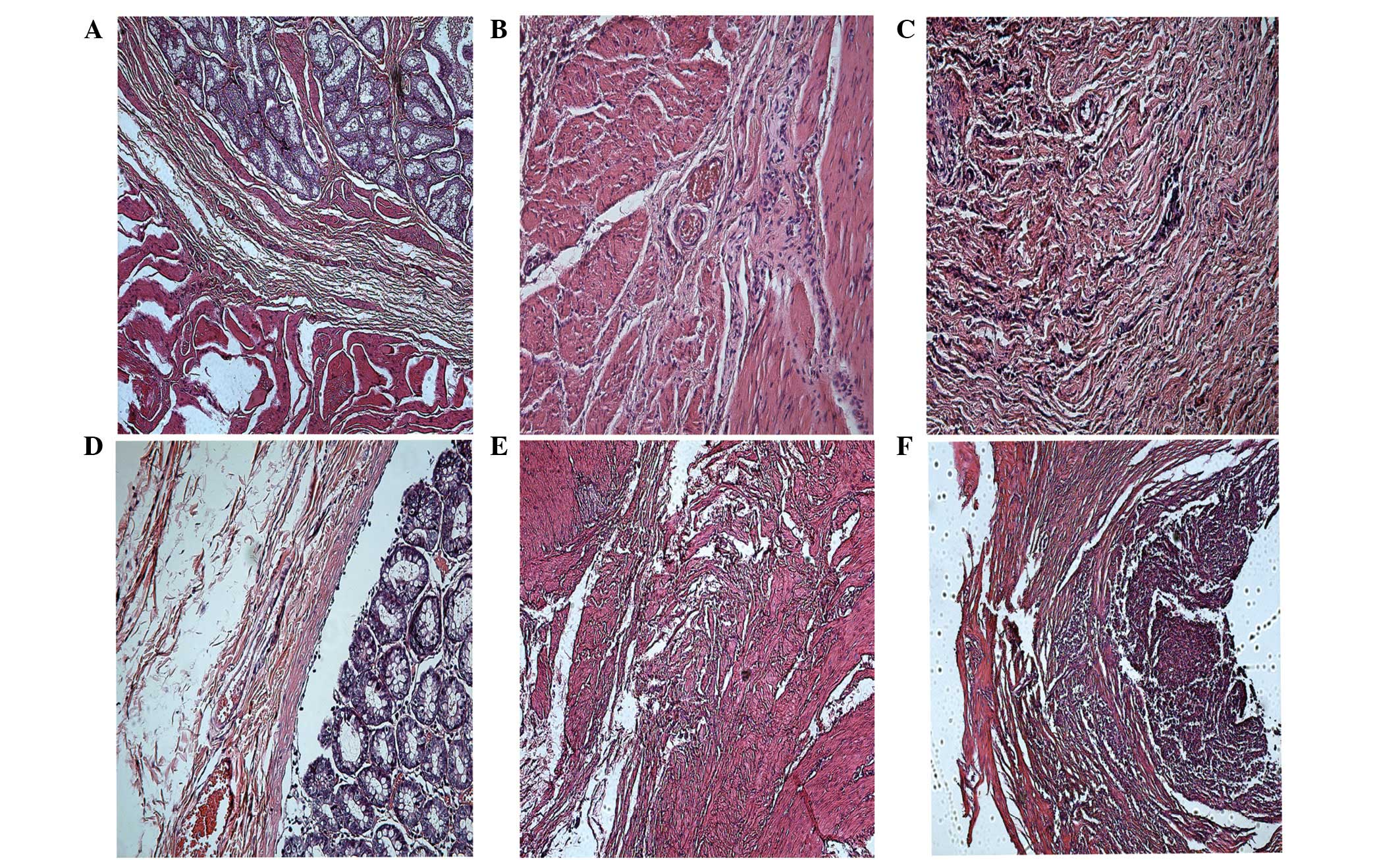|
1
|
Briel JW, Tamhankar AP, Hagen JA, et al:
Prevalence and risk factors for ischemia, leak, and stricture of
esophageal anastomosis: gastric pull-up versus colon interposition.
J Am Coll Surg. 198:536–542. 2004.
|
|
2
|
Kirat HT, Kiran RP, Lian L, Remzi FH and
Fazio VW: Influence of stapler size used at ileal pouch-anal
anastomosis on anastomotic leak, stricture, long-term functional
outcomes, and quality of life. Am J Surg. 200:68–72. 2010.
|
|
3
|
Polk HC, Cheadle WG and Frankllin GA:
Principles of operative surgery. Sabiston Textbook of Surgery: The
Biological Basis of Modern Surgical Practice. Towsend CM: 16th
edition. WB Saunders Company; St. Louis, MO: pp. 163–170. 2001
|
|
4
|
Graffner H, Andersson L, Löwenhielm P and
Walther B: The healing process of anastomoses of the colon. A
comparative study using single, double-layer or stapled
anastomosis. Dis Colon Rectum. 27:767–771. 1984.
|
|
5
|
Orringer MB, Marshall B and Iannettoni MD:
Eliminating the cervical esophagogastric anastomotic leak with a
side-to-side stapled anastomosis. J Thorac Cardiovasc Surg.
119:277–288. 2000.
|
|
6
|
Docherty JG, McGregor JR, Akyol AM, Murray
GD and Galloway DJ: Comparison of manually constructed and stapled
anastomoses in colorectal surgery. West of Scotland and Highland
Anastomosis Study Group. Ann Surg. 221:176–184. 1995.
|
|
7
|
Markar SR, Karthikesalingam A, Vyas S,
Hashemi M and Winslet M: Hand-sewn versus stapled oesophago-gastric
anastomosis: systematic review and meta-analysis. J Gastrointest
Surg. 15:876–884. 2011.
|
|
8
|
Ziv Y, Fazio VW, Church JM, et al: Stapled
ileal pouch anal anastomoses are safer than handsewn anastomoses in
patients with ulcerative colitis. Am J Surg. 171:320–323. 1996.
|
|
9
|
Orsay CP, Bass EM, Firfer B, Ramakrishnan
V and Abcarian H: Blood flow in colon anastomotic stricture
formation. Dis Colon Rectum. 38:202–206. 1995.
|
|
10
|
Chung RS: Blood flow in colonic
anastomoses. Effect of stapling and suturing. Ann Surg.
206:335–339. 1987.
|
|
11
|
Wong J, Cheung H, Lui R, et al:
Esophagogastric anastomosis performed with a stapler: the
occurrence of leakage and stricture. Surgery. 101:408–415.
1987.
|
|
12
|
Berrisford RG, Page RD and Donnelly RJ:
Stapler design and strictures at the esophagogastric anastomosis. J
Thorac Cardiovasc Surg. 111:142–146. 1996.
|
|
13
|
Ozkan O and Ozgentaş HE: Open guide suture
technique for safe microvascular anastomosis. Ann Plast Surg.
55:289–291. 2005.
|
|
14
|
Valdivieso A, Sarabia S, Pocino R, et al:
Is it worth using mechanical sutures in gastric surgery? Acta Chir
Belg. 95(Suppl 4): S179–S181. 1995.
|
|
15
|
Fok M, Ah-Chong AK, Cheng SW and Wong J:
Comparison of a single layer continuous hand-sewn method and
circular stapling in 580 oesophageal anastomoses. Br J Surg.
78:342–345. 1991.
|
|
16
|
Law S, Fok M, Chu KM and Wong J:
Comparison of hand-sewn and stapled esophagogastric anastomosis
after esophageal resection for cancer: a prospective randomized
controlled trial. Ann Surg. 226:169–173. 1997.
|
|
17
|
Hsu HH, Chen Js, Huang PM, Lee JM and Lee
YC: Comparison of manual and mechanical cervical esophagogastric
anastomosis after esophageal resection for squamous cell carcinoma:
a prospective randomized controlled trial. Eur J Cardiothorac Surg.
25:1097–1101. 2004.
|
|
18
|
Laterza E, de’Manzoni G, Veraldi GF, et
al: Manual compared with mechanical cervical oesophagogastric
anastomosis: a randomised trial. Eur J Surg. 165:1051–1054.
1999.
|
|
19
|
Valverde A, Hay JM, Fingerhut A and
Elhadad A: Manual versus mechanical esophagogastric anastomosis
after resection for carcinoma: a controlled trial. French
Associations for Surgical Research. Surgery. 120:476–483. 1996.
|
|
20
|
Walther B, Johansson J, Johnsson F, Von
Holstein CS and Zilling T: Cervical or thoracic anastomosis after
esophageal resection and gastric tube reconstruction: a prospective
randomized trial comparing sutured neck anastomosis with stapled
intrathoracic anastomosis. Ann Surg. 238:803–814. 2003.
|
|
21
|
Luechakiettisak P and Kasetsunthom S:
Comparison of hand-sewn and stapled in esophagogastric anastomosis
after esophageal cancer resection: a prospective randomized study.
J Med Assoc Thai. 91:681–685. 2008.
|
|
22
|
Okuyama M, Motoyama S, Suzuki H, et al:
Hand-sewn cervical anastomosis versus stapled intrathoracic
anastomosis after esophagectomy for middle or lower thoracic
esophageal cancer: a prospective randomized controlled study. Surg
Today. 37:947–952. 2007.
|
|
23
|
Craig SR, Walker WS, Cameron EW and
Wightman AJ: A prospective randomized study comparing stapled with
handsewn oesophagogastric anastomoses. J R Coll Surg Edinb.
41:17–19. 1996.
|
|
24
|
George WD: Suturing or stapling in
gastrointestinal surgery: a prospective randomize study. West of
Scotland and Highland Anastomosis Study Group. Br J Surg.
78:337–341. 1991.
|
|
25
|
Kuroyanagi H, Oya M, Ueno M, et al:
Standardized technique of laparoscopic intracorporeal rectal
transaction and anastomosis for low anterior resection. Surg
Endosc. 22:557–561. 2008.
|
|
26
|
Bärlehner E, Benhidjeb T, Anders S and
Schicke B: Laparoscopic resction for rectal cancer Outcomes in 194
patients and review of the literature. Surg Endosc. 19:757–766.
2005.
|
|
27
|
Scheidbach H, Schneider C, Konradt J, et
al: Laparoscopic abdominoperineal resection and anterior resection
with curative intent for carcinoma of the rectum. Surg Endosc.
16:7–13. 2002.
|
|
28
|
Karanjia ND, Corder AP, Holdsworth PJ and
Heald RJ: Risk of peritonitis and fatal septicaemia and the need to
defunction the low anastomosis. Br J Surg. 78:196–198. 1991.
|
|
29
|
Dziki AJ, Duncan MD, Harmon JW, et al:
Advantages of handsewn over stapled bowel anastomosis. Dis Colon
Rectum. 34:442–448. 1991.
|
|
30
|
Henriques AC, Godinho CA, Saad R Jr, et
al: Esophagogastric anastomosis with invagination into stomach: New
technique to reduce fistula formation. World J Gastroenterol.
16:5722–5726. 2010.
|
|
31
|
Valenzuela P, Saiz Puente MS, Valero JL,
et al: Continuous versus interrupted sutures for repair of
episiotomy or second-degree perineal tears: a randomised controlled
trial. BJOG. 116:436–441. 2009.
|
|
32
|
Shoji Y, Nihei Z, Hirayama R and Mishima
Y: Experiences with the linear cutter technique for performing
Roux-en-Y anastomosis following total gastrectomy. Surg Today.
25:27–31. 1995.
|
|
33
|
Hirahara N, Monma H, Shimojo Y, et al:
Reconstruction of the esophagojejunostomy by double stapling method
using EEA™ OrVil™ in laparoscopic total gastrectomy and proximal
gastrectomy. World J Surg Oncol. 9:552011.
|
|
34
|
Park KJ, Woo JS, Jeong SS and Yi JH:
Continuous ‘over and over’ suture for tricuspid ring annuloplasty.
Korean J Thorac Cardiovasc Surg. 45:19–23. 2012.
|


















